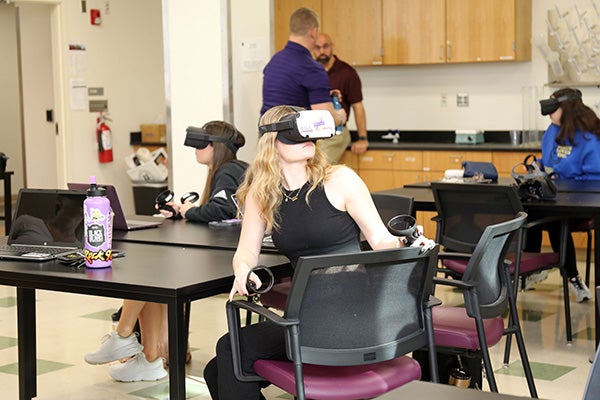Virtual, augmented reality engages students in science education, climate change
Research by two East Carolina University College of Education faculty members aims to bring the natural world to life for future teachers and K-12 students through augmented and virtual reality.
Mark Newton and Len Annetta are blending their respective areas of research in socioscientific issues and extended reality, which encompasses both augmented and virtual reality, to engage students in discussions around climate change and its effect on barrier islands.
“Prior to coming to ECU, I researched socioscientific issues — controversial issues that have some science component to them like climate change or wolves in Yellowstone,” said Newton, an assistant professor in science education. “My research has always been place-based, so I took students to these places, immersed them in the experience, and studied the issues in that context.”

Students in Mark Newton’s science education classes used virtual reality headsets to explore how climate change is affecting barrier islands like the Outer Banks. (ECU photo by Kristen Martin)
While highly educational, these types of trips can be expensive and dangerous. When Newton was looking to relocate to another university in 2019, he sought a school that had a fellow science education faculty member who was well-versed in augmented and virtual reality. He found that counterpart in Annetta, the Taft Distinguished Professor of Science Education, whose work explores the integration of innovative technology with STEM teaching and learning.
Both Newton and Annetta stressed how this technology can shape learning for students in K-12 classrooms — especially for those who may not have firsthand experience of the concepts they are learning. While teaching a class in graduate school in Missouri, Annetta compared harmonic waves in physics to waves in the ocean, only to realize seeing ocean waves in person wasn’t a shared experience for his students.
“I’m from the East Coast. …Everybody knew about waves,” he said. “But that example was a terrible example as a teacher because they have never experienced that. Virtual reality can now give everyone the same experience. It’s immersive enough where they can really feel like they were there.”
The duo has been testing the different types of augmented and virtual reality with students in Newton’s classes this semester to see how effective it can be.
Newton, along with fellow science education faculty Bonnie Glass and Tammy Lee, taught an Honors College seminar class in the spring on how climate change is affecting the Outer Banks. As part of the class, honors students took an alternative break trip to Nags Head and Ocracoke. Students used augmented reality to explore the Oregon Inlet Bridge and Cape Hatteras Lighthouse.
These experiences were then adapted into virtual reality so that students in Newton’s spring science education class were able to use VR headsets to explore those same locations while in their classroom in ECU’s Flanagan building.
“Using the headsets and exploring the Outer Banks with VR was a great way to make me feel like I was actually there,” said Veronykah Shafer, a junior science education major. “It also made me care a little more about the topic because I felt like I actually experienced the Outer Banks and it felt very relevant to me.”
Middle grades education major Haven Overcash said she would love to be able to use this type of technology in her future classroom to engage students the same way it engaged her in the topic.
Shafer noted that she would also like to incorporate this technology but said training for teachers is important so they feel confident using new technology in the classroom.
“Using AR/VR is also a really great way to get students excited about learning because this type of technology is something they are really interested in using,” Shafer said. “I also like how you can alter the VR to have questions and articles or sounds that you want the students to see and answer, which makes it great to use for your learning objectives.”
Beyond allowing students to experience places and scenarios they never have before, using extended reality furthers the goal of science education in creating scientifically literate citizens.
“My hopes are that by engaging in these technologies, they can weigh the science and the political, economic and cultural impacts,” Newton said. “They’re developing the skills that hopefully can translate to another issue, whether it be wind farms off the coast or offshore drilling. …developing that sort of functional scientific literacy so that we can have more literate students who are capable and willing to participate in coming up with sustainable solutions.”